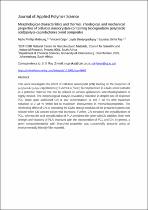 ResearchSpace
ResearchSpace
Morphological characteristics and thermal, rheological, and mechanical properties of cellulose nanocrystals-containing biodegradable poly(lactic acid)/poly(e-caprolactone) blend composites
JavaScript is disabled for your browser. Some features of this site may not work without it.
- ResearchSpace
- →
- Research Publications/Outputs
- →
- Journal Articles
- →
- View Item
| dc.contributor.author |
Motloung, Mpho P

|
|
| dc.contributor.author |
Ojijo, Vincent O

|
|
| dc.contributor.author |
Sinha Roy, Jayita

|
|
| dc.date.accessioned | 2020-03-19T12:11:30Z | |
| dc.date.available | 2020-03-19T12:11:30Z | |
| dc.date.issued | 2019-11 | |
| dc.identifier.citation | Motloung, M.P., Ojijo, V.O., Sinha Roy, J. & Ray, S.S. 2019. Morphological characteristics and thermal, rheological, and mechanical properties of cellulose nanocrystals-containing biodegradable poly(lactic acid)/poly(e-caprolactone) blend composites. Journal of Applied Polymer Science, vol. 137, pp. 1-11 | en_US |
| dc.identifier.issn | 0021-8995 | |
| dc.identifier.issn | 1097-4628 | |
| dc.identifier.uri | https://doi.org/10.1002/app.48665 | |
| dc.identifier.uri | https://onlinelibrary.wiley.com/doi/full/10.1002/app.48665 | |
| dc.identifier.uri | http://hdl.handle.net/10204/11366 | |
| dc.description | Copyright: 2019, Wiley Online Library Due to copyright restrictions, the attached PDF file contains the abstract version of the full-text item. For access to the full-text item, please consult the publisher's website. The definitive version of the work is published in the Journal of Applied Polymer Science, vol. 137, pp. 1-11 | en_US |
| dc.description.abstract | This work investigates the effect of cellulose nanocrystal (CN) loading on the properties of polylactide/poly(e-caprolactone) (PLA/PCL) (70/30) blend processed in a twin-screw extruder as a potential material that can be utilized in various applications where biodegradation is highly desired. The morphological analysis revealed a reduction in droplet size of dispersed PCL phase upon addition of CN at low concentrations (1 and 2 wt %) with maximum reduction at 2 wt % which led to maximum improvement in mechanical properties. The reinforcing effect of CN in increasing the DMA storage modulus of the prepared systems was noticed when CN concentration was increased. Further, CN enhanced the crystallization of PCL, whereas the cold crystallization of PLA remained the same with CN addition. Both melt strength and viscosity of PLA improved with the incorporation of PCL and CN. In general, a green composite material with improved properties was successfully prepared using an environmentally friendly filler material. | en_US |
| dc.language.iso | en | en_US |
| dc.publisher | Wiley Online Library | en_US |
| dc.relation.ispartofseries | Workflow;23047 | |
| dc.subject | Biodegradable | en_US |
| dc.subject | Nanocrystals | en_US |
| dc.subject | Nanoparticles | en_US |
| dc.subject | Nanowires | en_US |
| dc.title | Morphological characteristics and thermal, rheological, and mechanical properties of cellulose nanocrystals-containing biodegradable poly(lactic acid)/poly(e-caprolactone) blend composites | en_US |
| dc.type | Article | en_US |
| dc.identifier.apacitation | Motloung, M. P., Ojijo, V. O., & Sinha Roy, J. (2019). Morphological characteristics and thermal, rheological, and mechanical properties of cellulose nanocrystals-containing biodegradable poly(lactic acid)/poly(e-caprolactone) blend composites. http://hdl.handle.net/10204/11366 | en_ZA |
| dc.identifier.chicagocitation | Motloung, Mpho P, Vincent O Ojijo, and Jayita Sinha Roy "Morphological characteristics and thermal, rheological, and mechanical properties of cellulose nanocrystals-containing biodegradable poly(lactic acid)/poly(e-caprolactone) blend composites." (2019) http://hdl.handle.net/10204/11366 | en_ZA |
| dc.identifier.vancouvercitation | Motloung MP, Ojijo VO, Sinha Roy J. Morphological characteristics and thermal, rheological, and mechanical properties of cellulose nanocrystals-containing biodegradable poly(lactic acid)/poly(e-caprolactone) blend composites. 2019; http://hdl.handle.net/10204/11366. | en_ZA |
| dc.identifier.ris | TY - Article AU - Motloung, Mpho P AU - Ojijo, Vincent O AU - Sinha Roy, Jayita AB - This work investigates the effect of cellulose nanocrystal (CN) loading on the properties of polylactide/poly(e-caprolactone) (PLA/PCL) (70/30) blend processed in a twin-screw extruder as a potential material that can be utilized in various applications where biodegradation is highly desired. The morphological analysis revealed a reduction in droplet size of dispersed PCL phase upon addition of CN at low concentrations (1 and 2 wt %) with maximum reduction at 2 wt % which led to maximum improvement in mechanical properties. The reinforcing effect of CN in increasing the DMA storage modulus of the prepared systems was noticed when CN concentration was increased. Further, CN enhanced the crystallization of PCL, whereas the cold crystallization of PLA remained the same with CN addition. Both melt strength and viscosity of PLA improved with the incorporation of PCL and CN. In general, a green composite material with improved properties was successfully prepared using an environmentally friendly filler material. DA - 2019-11 DB - ResearchSpace DP - CSIR KW - Biodegradable KW - Nanocrystals KW - Nanoparticles KW - Nanowires LK - https://researchspace.csir.co.za PY - 2019 SM - 0021-8995 SM - 1097-4628 T1 - Morphological characteristics and thermal, rheological, and mechanical properties of cellulose nanocrystals-containing biodegradable poly(lactic acid)/poly(e-caprolactone) blend composites TI - Morphological characteristics and thermal, rheological, and mechanical properties of cellulose nanocrystals-containing biodegradable poly(lactic acid)/poly(e-caprolactone) blend composites UR - http://hdl.handle.net/10204/11366 ER - | en_ZA |





